Abstract
The metabolism of endogenous arachidonic acid P(AA) was investigated in activated neutrophils from 20 patients with Crohn's disease, 20 with ulcerative colitis, and 25 healthy volunteers. 1-14C-P(AA) was incorporated into intracellular pools of phospholipids prior to activation of the cells with ionophore A23187 and analyses of released arachidonic acid metabolites by thin layer chromatography. Total release of radioactivity expressing the release of arachidonic acid and its metabolites, was equal in the experimental and control groups, which suggests a normal substrate availability. In contrast, there was a marked increase in the relative release of leucotriene B4 (LTB4) and its omega-oxidation products, 20-hydroxy-LTB4 (20-OH-LTB4) and 20-carboxy-LTB4 (20-COOH-LTB4), with LTB4 values exceeding the reference interval in seven of 20 patients with Crohn's disease, median 8.7%, and in six of 20 patients with ulcerative colitis, median 7.7%, as compared with a median of 5.3% in healthy volunteers. Furthermore, a decreased release of unmetabolised arachidonic acid, correlating inversely with the release of LTB4 in all experimental and control groups, and normal values for the production of other metabolites of arachidonic acid--for example, 5-hydroxyeicosatetraenoic acid (5-HETE) and 12-hydroxyheptadecatrienoic acid (HHT), point to an enzymatic abnormality such as increased activity of leucotriene B synthetase. An increased capacity for release of LTB4, the major pro-inflammatory metabolite of arachidonic acid lipoxygenation by polymorphonuclear leucocytes, may contribute to perpetuation of the inflammation and to tissue destruction in chronic inflammatory bowel disease. Our findings agree with previous reports of an increased release of LTB4 by the colonic mucosa in this condition.
Full text
PDF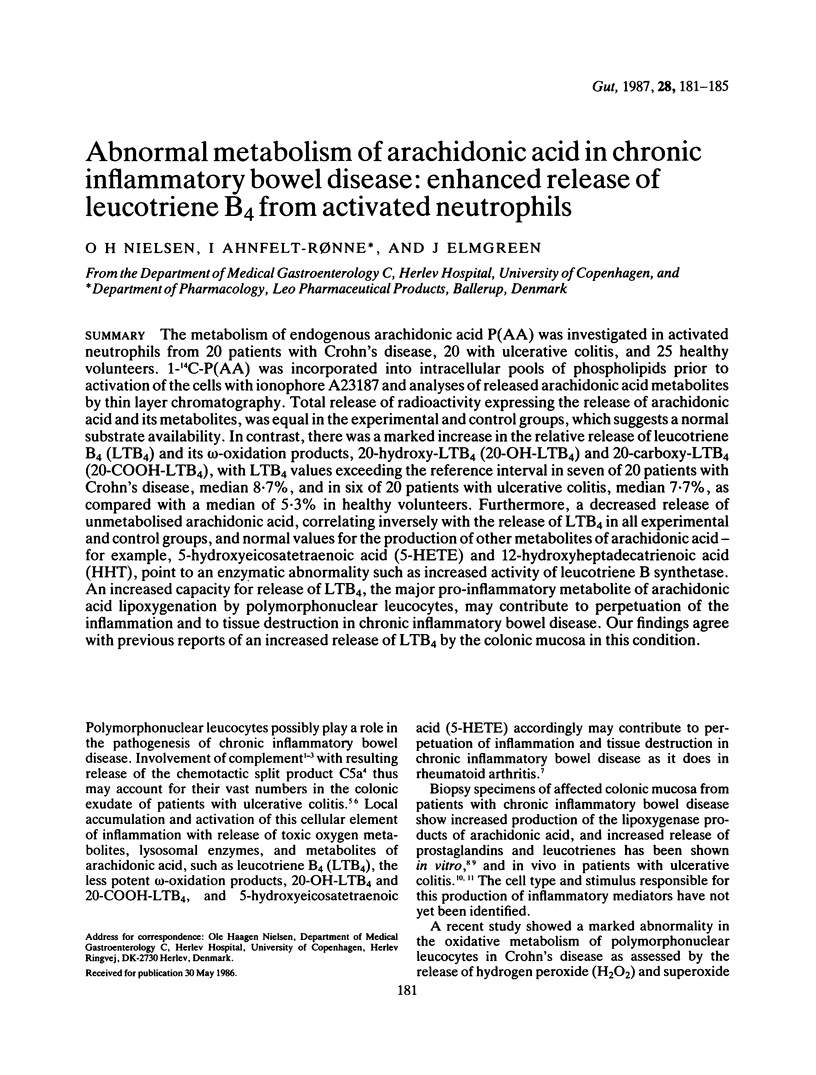
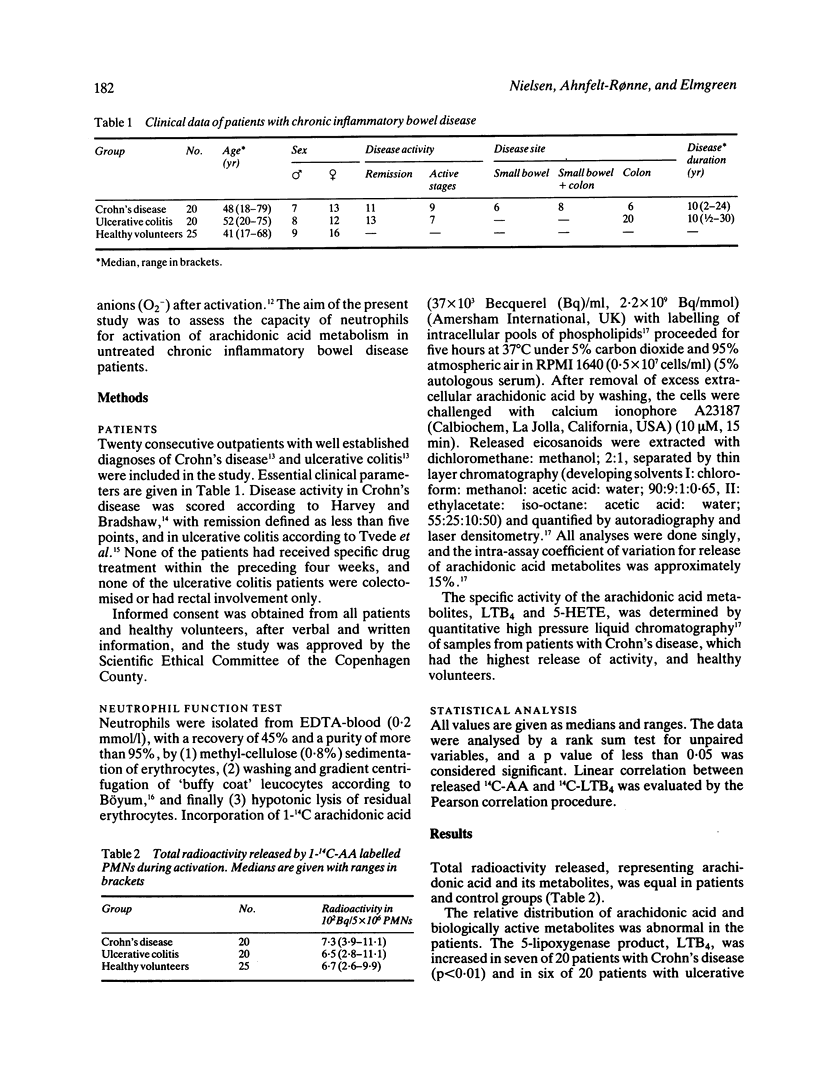
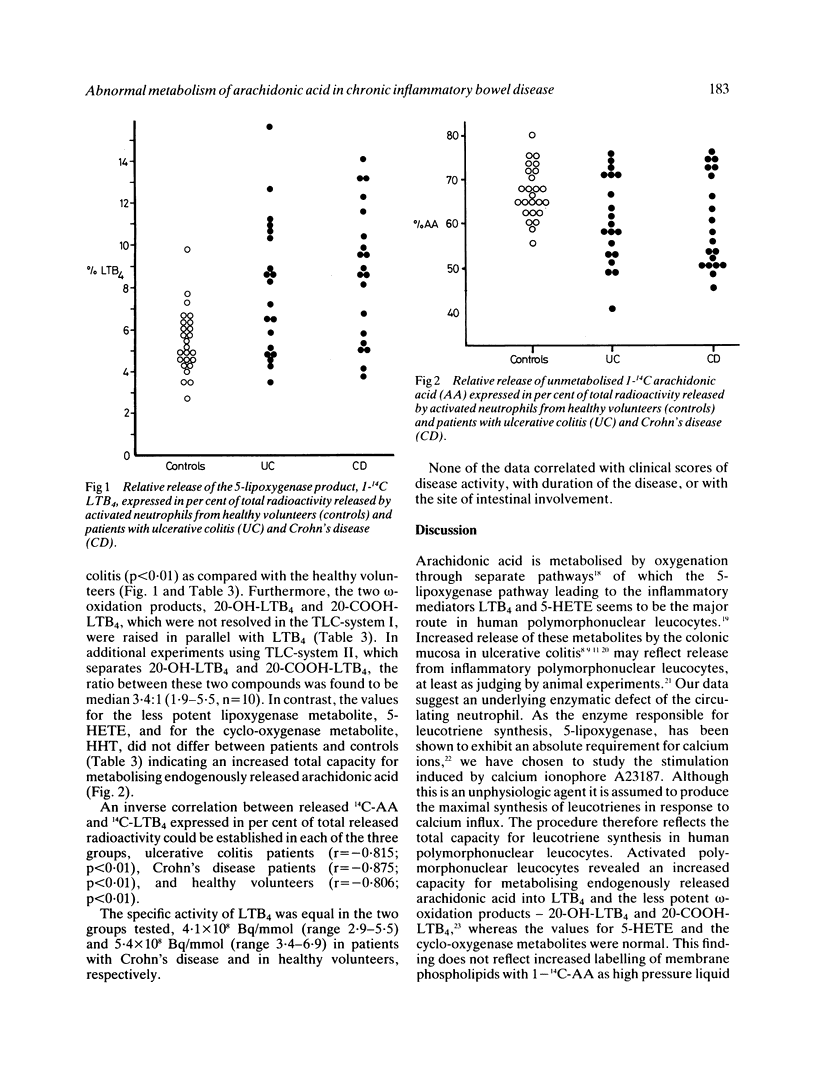
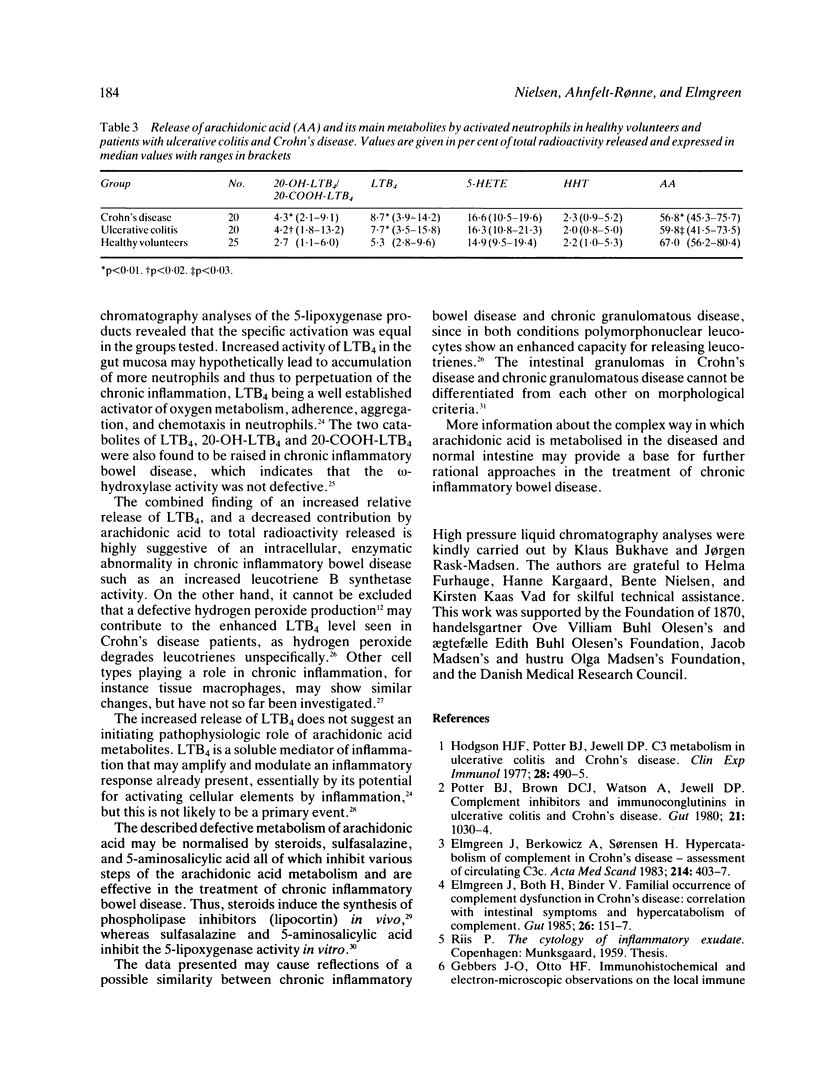
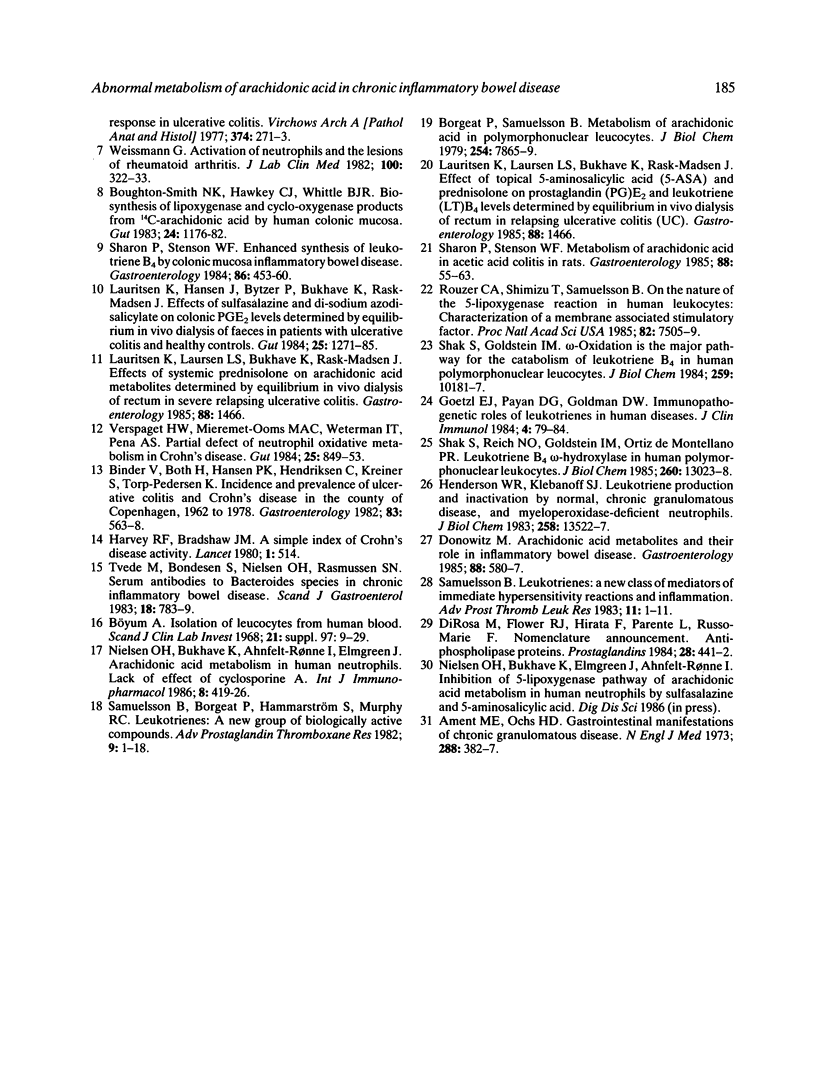
Selected References
These references are in PubMed. This may not be the complete list of references from this article.
- Ament M. E., Ochs H. D. Gastrointestinal manifestations of chronic granulomatous disease. N Engl J Med. 1973 Feb 22;288(8):382–387. doi: 10.1056/NEJM197302222880802. [DOI] [PubMed] [Google Scholar]
- Binder V., Both H., Hansen P. K., Hendriksen C., Kreiner S., Torp-Pedersen K. Incidence and prevalence of ulcerative colitis and Crohn's disease in the County of Copenhagen, 1962 to 1978. Gastroenterology. 1982 Sep;83(3):563–568. [PubMed] [Google Scholar]
- Borgeat P., Samuelsson B. Metabolism of arachidonic acid in polymorphonuclear leukocytes. Structural analysis of novel hydroxylated compounds. J Biol Chem. 1979 Aug 25;254(16):7865–7869. [PubMed] [Google Scholar]
- Boughton-Smith N. K., Hawkey C. J., Whittle B. J. Biosynthesis of lipoxygenase and cyclo-oxygenase products from [14C]-arachidonic acid by human colonic mucosa. Gut. 1983 Dec;24(12):1176–1182. doi: 10.1136/gut.24.12.1176. [DOI] [PMC free article] [PubMed] [Google Scholar]
- Böyum A. Isolation of leucocytes from human blood. A two-phase system for removal of red cells with methylcellulose as erythrocyte-aggregating agent. Scand J Clin Lab Invest Suppl. 1968;97:9–29. [PubMed] [Google Scholar]
- Di Rosa M., Flower R. J., Hirata F., Parente L., Russo-Marie F. Anti-phospholipase proteins. Prostaglandins. 1984 Oct;28(4):441–442. doi: 10.1016/0090-6980(84)90232-6. [DOI] [PubMed] [Google Scholar]
- Donowitz M. Arachidonic acid metabolites and their role in inflammatory bowel disease. An update requiring addition of a pathway. Gastroenterology. 1985 Feb;88(2):580–587. doi: 10.1016/0016-5085(85)90525-6. [DOI] [PubMed] [Google Scholar]
- Elmgreen J., Berkowicz A., Sørensen H. Hypercatabolism of complement in Crohn's disease--assessment of circulating C3c. Acta Med Scand. 1983;214(5):403–407. doi: 10.1111/j.0954-6820.1983.tb08615.x. [DOI] [PubMed] [Google Scholar]
- Elmgreen J., Both H., Binder V. Familial occurrence of complement dysfunction in Crohn's disease: correlation with intestinal symptoms and hypercatabolism of complement. Gut. 1985 Feb;26(2):151–157. doi: 10.1136/gut.26.2.151. [DOI] [PMC free article] [PubMed] [Google Scholar]
- Goetzl E. J., Payan D. G., Goldman D. W. Immunopathogenetic roles of leukotrienes in human diseases. J Clin Immunol. 1984 Mar;4(2):79–84. doi: 10.1007/BF00915039. [DOI] [PubMed] [Google Scholar]
- Harvey R. F., Bradshaw J. M. A simple index of Crohn's-disease activity. Lancet. 1980 Mar 8;1(8167):514–514. doi: 10.1016/s0140-6736(80)92767-1. [DOI] [PubMed] [Google Scholar]
- Henderson W. R., Klebanoff S. J. Leukotriene production and inactivation by normal, chronic granulomatous disease and myeloperoxidase-deficient neutrophils. J Biol Chem. 1983 Nov 25;258(22):13522–13527. [PubMed] [Google Scholar]
- Hodgson H. J., Potter B. J., Jewell D. P. C3 metabolism in ulcerative colitis and Crohn's disease. Clin Exp Immunol. 1977 Jun;28(3):490–495. [PMC free article] [PubMed] [Google Scholar]
- Lauritsen K., Hansen J., Bytzer P., Bukhave K., Rask-Madsen J. Effects of sulphasalazine and disodium azodisalicylate on colonic PGE2 concentrations determined by equilibrium in vivo dialysis of faeces in patients with ulcerative colitis and healthy controls. Gut. 1984 Nov;25(11):1271–1278. doi: 10.1136/gut.25.11.1271. [DOI] [PMC free article] [PubMed] [Google Scholar]
- Nielsen O. H., Bukhave K., Ahnfelt-Rønne I., Elmgreen J. Arachidonic acid metabolism in human neutrophils: lack of effect of cyclosporine A. Int J Immunopharmacol. 1986;8(4):419–426. doi: 10.1016/0192-0561(86)90126-8. [DOI] [PubMed] [Google Scholar]
- Potter B. J., Brown D. J., Watson A., Jewell D. P. Complement inhibitors and immunoconglutinins in ulcerative colitis and Crohn's disease. Gut. 1980 Dec;21(12):1030–1034. doi: 10.1136/gut.21.12.1030. [DOI] [PMC free article] [PubMed] [Google Scholar]
- Rouzer C. A., Shimizu T., Samuelsson B. On the nature of the 5-lipoxygenase reaction in human leukocytes: characterization of a membrane-associated stimulatory factor. Proc Natl Acad Sci U S A. 1985 Nov;82(22):7505–7509. doi: 10.1073/pnas.82.22.7505. [DOI] [PMC free article] [PubMed] [Google Scholar]
- Samuelsson B. Leukotrienes: a new class of mediators of immediate hypersensitivity reactions and inflammation. Adv Prostaglandin Thromboxane Leukot Res. 1983;11:1–13. [PubMed] [Google Scholar]
- Shak S., Goldstein I. M. Omega-oxidation is the major pathway for the catabolism of leukotriene B4 in human polymorphonuclear leukocytes. J Biol Chem. 1984 Aug 25;259(16):10181–10187. [PubMed] [Google Scholar]
- Shak S., Reich N. O., Goldstein I. M., Ortiz de Montellano P. R. Leukotriene B4 omega-hydroxylase in human polymorphonuclear leukocytes. Suicidal inactivation by acetylenic fatty acids. J Biol Chem. 1985 Oct 25;260(24):13023–13028. [PubMed] [Google Scholar]
- Sharon P., Stenson W. F. Enhanced synthesis of leukotriene B4 by colonic mucosa in inflammatory bowel disease. Gastroenterology. 1984 Mar;86(3):453–460. [PubMed] [Google Scholar]
- Sharon P., Stenson W. F. Metabolism of arachidonic acid in acetic acid colitis in rats. Similarity to human inflammatory bowel disease. Gastroenterology. 1985 Jan;88(1 Pt 1):55–63. doi: 10.1016/s0016-5085(85)80132-3. [DOI] [PubMed] [Google Scholar]
- Tvede M., Bondesen S., Nielsen O. H., Rasmussen S. N. Serum antibodies to Bacteroides species in chronic inflammatory bowel disease. Scand J Gastroenterol. 1983 Sep;18(6):783–789. doi: 10.3109/00365528309182095. [DOI] [PubMed] [Google Scholar]
- Verspaget H. W., Mieremet-Ooms M. A., Weterman I. T., Peña A. S. Partial defect of neutrophil oxidative metabolism in Crohn's disease. Gut. 1984 Aug;25(8):849–853. doi: 10.1136/gut.25.8.849. [DOI] [PMC free article] [PubMed] [Google Scholar]
- Weissmann G. Activation of neutrophils and the lesions of rheumatoid arthritis. J Lab Clin Med. 1982 Sep;100(3):322–333. [PubMed] [Google Scholar]


